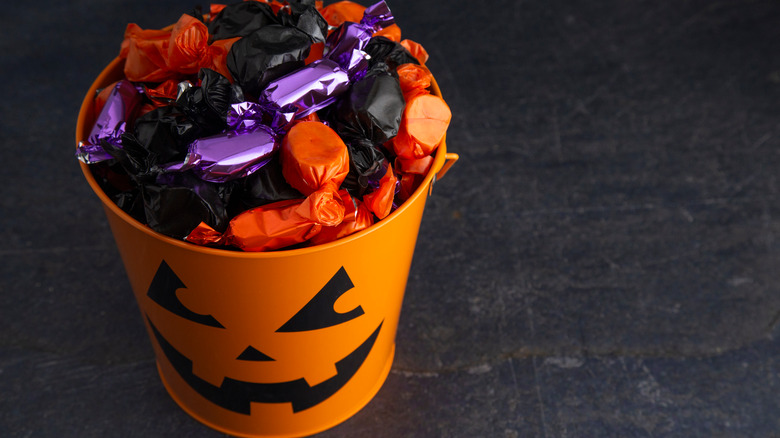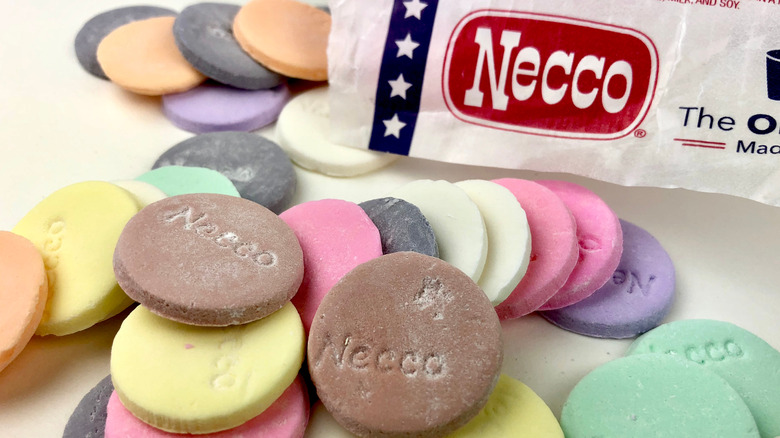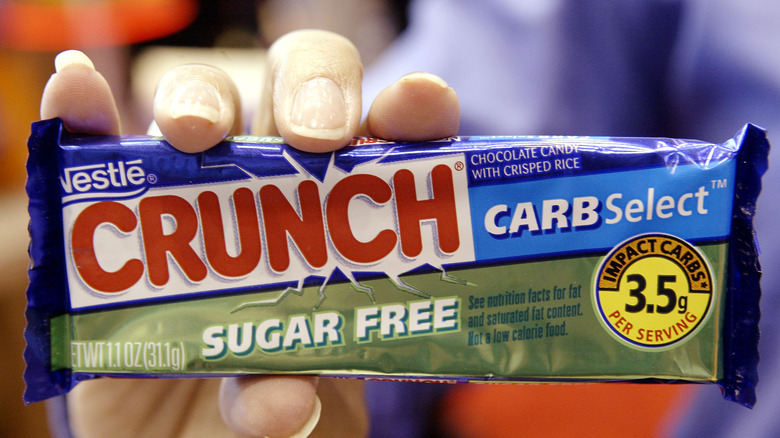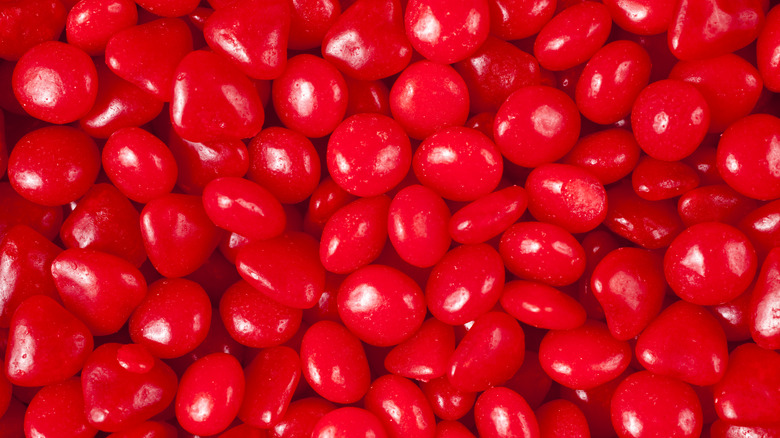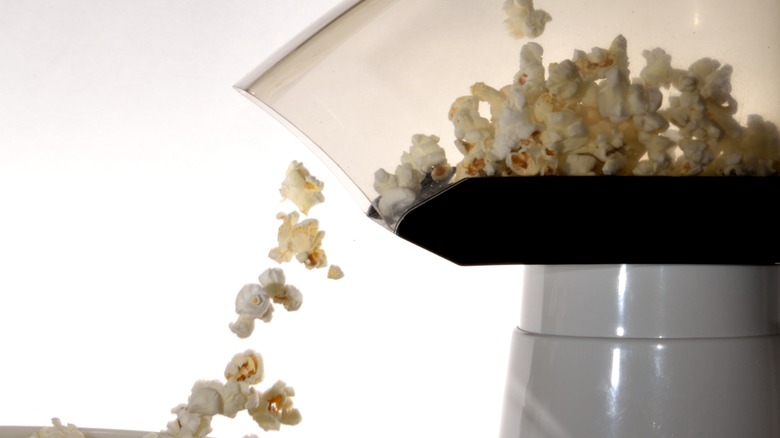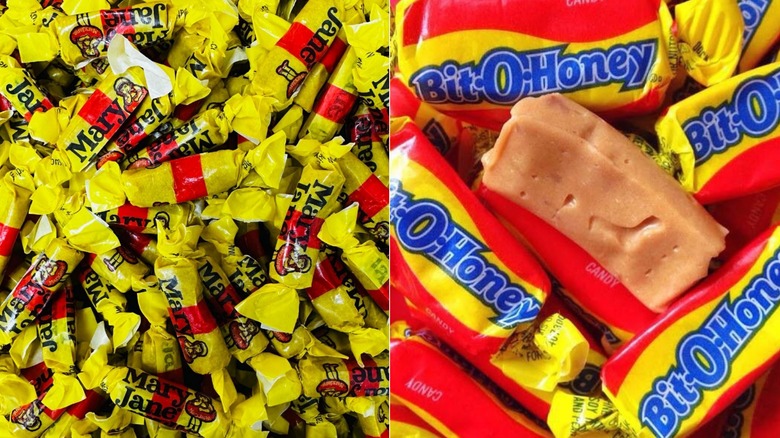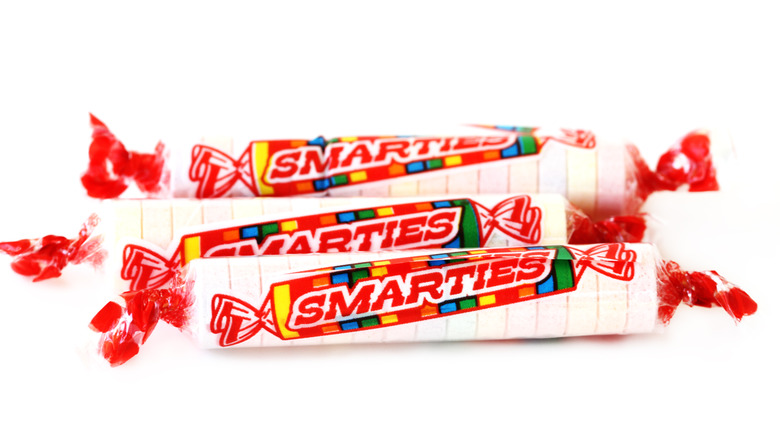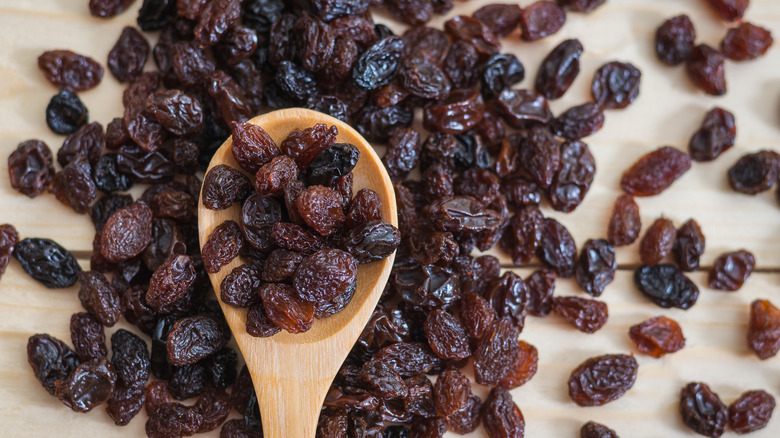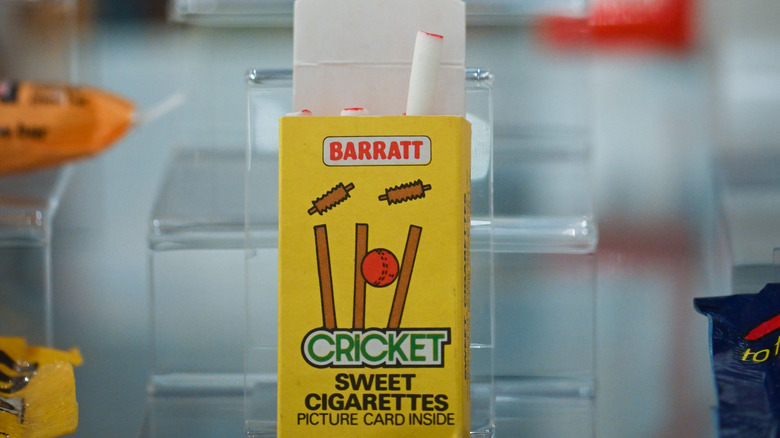The Worst Treats To Get In Your Trick-Or-Treat Bag, According To Mashed Staff
For kids who love candy (which is pretty much every kid), Halloween is the most glorious of holidays, as the climax of it all revolves around unadulterated enjoyment of the sweet stuff. We're talking of course about trick-or-treating. That ever-so-popular tradition that dates back hundreds of years with children putting on costumes and asking neighbors for a treat, in lieu of a trick, should the neighbor decline.
While every trick-or-treater undoubtedly has their favorite treat, with Snickers, Reese's, and M&M's being some of the most popular Halloween candies, there are also those treats many kids dread finding in their bag. While most of us were probably not as unfortunate as poor ol' Charlie Brown, who finished his candy run with nothing more than a bag of rocks, just about everyone can name one Halloween candy they despise.
Our trick-or-treating days are long behind us, but even in adulthood, there are certain "treats" the Mashed staff feel have no business being handed out on Halloween.
Necco wafers - Crysta Coburn
Did you know one of the eight Necco Wafer flavors is clove? Clove! (It's the light purple one.) That may have been popular in 1847, when Necco Wafers were first introduced, but in the 21st century, little could be more disappointing in a trick-or-treat bag than a roll of Necco Wafers.
The other flavors really do not improve the situation since they all taste (term used loosely) very similar to each other. They are lemon (yellow), lime (green), orange (orange), cinnamon (white), wintergreen (pink), licorice (dark gray), and chocolate (brown). At least half of these are not popular flavors with children. (Again, clove?)
Yet, Necco Wafers have withstood the test of time, and they even came back after a brief absence between owners. They were mailed to soldiers during World War II because, unlike chocolate, they do not melt. Hats off to that. It's impressive and historical, and fans are more than welcome to them. But must unsuspecting young trick-or-treaters be subjected to these round slivers of brightly colored chalk?
Sugar-free candy - Brian Boone
To consciously and emphatically decide against handing out sugar-loaded candy to trick-or-treaters is to betray the whole idea of Halloween. It's the one night a year when kids can seek out the one thing they love and desire the most, candy, with abandon and without parents telling them to cool it on the unhealthy treats. Those kids go door-to-door in search of full-fledged candy, and those who dispense sugar-free candy are guilty of bait-and-switch.
Furthermore, while sugar-free candy may not have sugar in it, it's not particularly healthy. Sugar-free candy is also not a golden ticket for those living with diabetes. Most of it has a similar calorie count to its better brethren, as manufacturers load it up with fats and chemically sugar substitutes. And that right there is the other main reason why it's a bad idea to reward trick-or-treaters with sugar-free candy. When you hand out sugar-free candy, you're handing out gastrointestinal distress. The body doesn't quite know how to digest those fake sugars, and it responds by ordering a full, and repeated, evacuation.
So skip the sugar-free Hershey Bars and Reese's Peanut Butter Cups and give out the real deal instead. They'll make everyone happy and avoid incontinence.
School supplies - Adam Swierk
I've never understood why anyone would choose to participate in the great American tradition of trick-or-treating ... yet opt against handing out a standard batch of fun size candies. There are literally dozens of popular miniature, individually wrapped candies on the market, after all, from Hershey and Mars and Nestle (oh, my!). Of course, while I can accept those budget-friendly and nostalgically-driven folks who gave out Tootsie Rolls or Smarties, I'll never forgive (or forget) those dingleberries who gave me and my fellow neighborhood kids pencils and erasers in lieu of sweet treats.
Simply put? People unwilling to give out actual candy to children on Halloween should just leave the porch light off and abstain from the whole Halloween tradition. Even if the pencils were adorned with spookily appropriate designs — think green-and-purple witches, or orange-and-yellow jack-o-lanterns — the bottom line remained the same: I wanted candy from my childhood neighbors, not school supplies. And considering television's greatest teacher Mr. Feeny (William Daniels) gave out rulers and pocket dictionaries to uninterested trick-or-treaters on a pair of "Boy Meets World" holiday episodes, as well? I clearly wasn't the only child deprived of candy during my youthful All Hallow's Eve excursions.
As a kid, obtaining an unholy amount of candy is, quite literally, the only reasonable outcome to trick-or-treating. You're supposed to be able to eat whatever ends up in your plastic pumpkin pail or pillow case — and a pair of pencils to chomp on in class never fit that bill.
Red Hots - Ellie Barbee
There is pleasant spicy, and then there is not-so-pleasant spicy ... and in the case of the candy known as Red Hots, the heat which sears your tongue is not of the good kind. Red Hots are a cinnamon-flavored candy intended to give you an enjoyable, sweet-and-spicy kick ... but all I have found them to do is burn. Pulling a box of these tiny, red, and chewy rounds from within your trick-or-treat bag is guaranteed to blow up my mouth with a burst of artificial, unappealing, and overwhelming cinnamon flavor which will overpower the senses ... and likely destroy my palate for the remainder of the evening.
Trust me. The last thing you want to do is render the other far superior candy choices in your tote bag tasteless on a night where there are so many to sample. If making yourself cry and reach desperately for the nearest water bottle is your jam, then Red Hots might be for you ... just don't mind me when I pass an unopened box your way for a trade of literally any other type of edible holiday favor.
Popcorn - Becki Robins
Popcorn is a great snack ... when it's freshly popped, smothered in fake butter, and you're eating it in a movie theater or in front of the TV. It is not a great snack when it's two days old, dry, and seasoned with table salt (which by the way does not even stick to dry popcorn). Friends, you may think you're doing the kids a favor by filling Halloween-themed Ziplock bags with healthy, non-fat, no-sugar, air-popped non-treats but take note, the only reason those kids are going to reach into their pumpkin-shaped trick-or-treat buckets in search of that bag of popcorn is because it's blocking access to the Snickers and Reese's Peanut Butter Cups and there's a trash can nearby.
If you're taking it upon yourself to single-handedly bring good health to your neighborhood trick-or-treaters, it might be helpful to be told that your good intentions are misguided. One bag of flavorless popcorn is not going to offset the 2 gazillion calories and 74 million grams of sugar present in every trick-or-treater's bag at the end of a productive All Hallows' Eve. If you're that opposed to giving kids candy, skip the candy hand-out and go to dinner instead. There's no need to become the most disappointing house on the block.
If you do still insist on spending the pre-Halloween hours filling plastic baggies with stale popcorn, make sure you're also practicing your evil laugh because you are the most diabolical thing in the neighborhood.
Nutty taffy - Jenny Kellerhals
Peanut butter taffy is not a treat. It's the worst kind of trick. And it's not just peanut butter. It's every kind of nutty taffy that somehow ends up at the bottom of trick-or-treat bags every year — the biggest offenders being the Mary Jane and Bit-O-Honey taffy candies. How these candies are made with otherwise beloved peanut butter and roasted almonds, and manage to be so completely inedible is a mystery that has persisted for decades.
Originally created in 1914, Mary Jane candy consisted of a bittersweet molasses-flavored taffy that was somehow stuffed with the driest and grainiest peanut butter you've ever tasted. The ultra-chewy Bit-O-Honey taffy has been around since 1924 and includes more almonds than actual honey, according to the ingredients list. The roasted almond bits studded throughout the candy taste more like tiny pieces of cardboard that got stuck in a bland one-note taffy sometime during production. Both are incredibly difficult to chew and aren't worth any potential dental issues they could definitely cause.
Unable to trade them away after trick-or-treating, I'd save the nutty taffies from my Halloween haul every year until all the other candy was gone. Desperate to keep the sugar rush going, I'd finally reach for a piece of one of these candies, but regret the decision as soon as the musty and grainy peanut butter taste hit my tongue. That's how I knew Halloween was officially over, and it was time to move on to a much tastier Thanksgiving.
Smarties - Mary K. Cahill
One of the best parts of trick-or-treating is coming home with a pillowcase full of candy (note: serious trick-or-treaters collect their loot in pillowcases) and dumping it out to commence a trading frenzy with your crew. That's when you see the Smarties roll out, and immediately start trying to pawn them off for something a little more indulgent. You know, like chocolate. Smarties (not to be confused with Nestlé's chocolate-based candy of the same name that's sold abroad) are something of a baby sister to the Necco Wafer. The tablet-sized candy has a hard, powdery exterior and a brittle, chalky interior. Sounds tempting right? A standard roll contains a stack of 15 Smarties in an assortment of pastel hues. Luckily the slender packaging makes them a little easier to avoid in your neighbor's Halloween candy bowl.
Smarties aren't as ancient as Necco Wafers but they've been around since 1949. Edward Dee founded Smarties in New Jersey and his signature candies are still produced in family-owned factories today. We respect Smarties' longtime indie status but a pile of these bad boys fails to satisfy our sweet tooth. Maybe that's also because Smarties (which are little more than dextrose, citric acid, artificial flavors, and food coloring) taste kind of salty. Come to find out, the different colors actually are different flavors. The white Smartie is orange-cream (could've fooled us!), yellow is pineapple, pink is cherry, green is strawberry, purple is grape, and orange, per usual, is orange.
Raisins - Suzanne S. Wiley
Raisins are a lunchbox snack, not a Halloween treat. I say this as someone who likes raisins in general and who snacks on them frequently. These are not special treats that kids look forward to having on one holiday, they're things kids eat routinely. Where's the fun in getting a bag full of that?
The Boston Globe spoke with people who hand out things like raisin boxes and found that, for most households, it was an attempt to avoid giving out sugar, rather than any deliberate effort to be awful. (Except for one guy who admitted to giving out almonds "just to be an idiot.") Even the Sun-Maid company admits no one wants raisins. I have to give them credit for embracing their reputation and creating a "raisin house of horrors" in 2022 in St. Helens, Oregon.
If you don't want to give out sugar this year, I get it. But don't resort to raisins; that reminds kids of school lunches. Instead, make your house an allergy-friendly one and hand out a variety of fun toys like sticker packs and bubble wands. Food Allergy Research and Education has a list of suggestions. One of the people interviewed by the Globe has handed out things like fidget spinners, too. And a note for those who think pencils are a good alternative: Don't. If you're really into providing school supplies, donate them to your local school district or to a charity that helps transfer those supplies to districts in need.
Candy cigarettes - Crawford Smith
I have many memories of childhood Halloweens cracking open a pack of candy cigarettes, distributing the chalky white sticks to my friends, and puffing on them like a character in a 1940s film noir flick. It wasn't because they tasted good — they're typically made with dextrose, corn starch, and gelatin, and they have the dry texture and almost complete lack of flavor you'd expect based on that ingredient list. No, my friends and I liked them because we thought smoking was cool, and candy cigarettes gave us a way to play-act the motions of smoking. I'm not old enough to remember when candy cigarettes were packaged in boxes with real cigarette brands' logos on them, but the packs were still obviously influenced by Marlboro, Camel, Pall-Mall, etc.
Did I and most of the people I grew up with end up smoking cigarettes when we got older? Would it shock you that the answer is yes? I can't lay the responsibility for this solely at the feet of candy cigarette manufacturers, but it's hard to imagine these evil confections didn't play some role. Thankfully, these things seem to be less popular and harder to get than they used to, because every time a pack gets thrown into a trick-or-treater's candy bag, it's subtly setting them up to develop a habit they'll regret later. Times have changed — we imagine there would be an uproar if someone started handing out gummy Elf Bars or bubblegum Juul replicas this Halloween.
